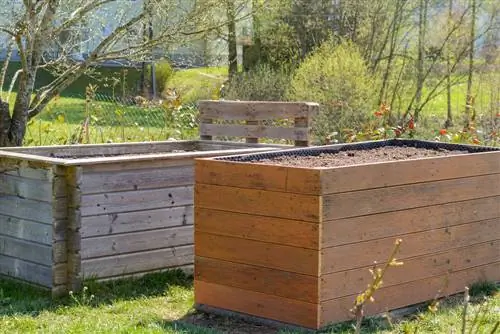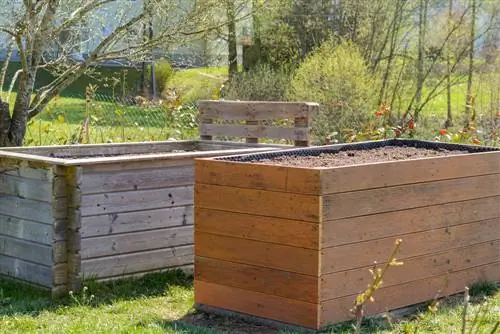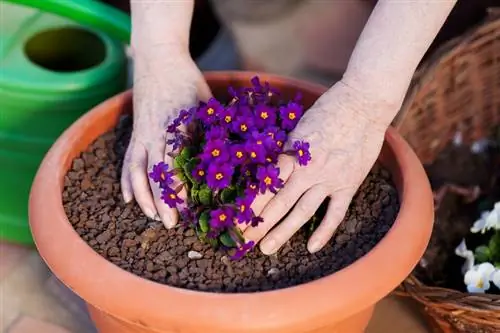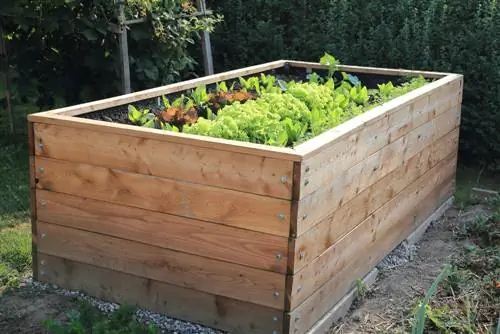- Author admin [email protected].
- Public 2023-12-16 16:46.
- Last modified 2025-01-23 11:21.
Wood is probably the most commonly used building material for raised beds. It is easy to obtain in hardware stores, specialist retailers or even in forestry companies and is very easy to handle in terms of transport and processing. In addition, wood is a renewable raw material and as such is ecological - provided you do not buy boards glazed with toxic paints.

Which types of wood are suitable for raised beds?
Softwoods such as spruce, pine, Douglas fir and poplar, which rot more quickly, as well as more resistant hardwoods such as larch, robinia, black pine and oak are suitable for raised beds. Impregnated wood should only be used for raised beds for ornamental plants.
Which types of wood are suitable for building raised beds?
You can choose between softwoods and hardwoods, each with specific advantages and disadvantages. Softwoods such as spruce, pine, Douglas fir or poplar are usually extremely inexpensive to purchase. However, these types of wood rot within a few years, especially when they come into contact with moist soil (as is unavoidable in a raised bed). Untreated spruce wood, for example, needs to be replaced after around three to four years. However, you can extend the durability through protective measures such as attaching studded or pond liner to the inside and a protective glaze. However, the most resistant to moisture and rot is hardwood such as larch, black locust, black pine or oak. However, these woods have their price and are therefore significantly more expensive to purchase.
Use impregnated wood only for raised beds for ornamental plants
The durability of softwoods in particular can be extended somewhat by using a glaze or impregnation. However, these are only suitable for raised beds for ornamental plants. However, you should not use materials treated in this way for raised vegetable and herb beds, as the chemicals can leach into the soil and thus into the vegetables and fruits. Instead, you can resort to non-toxic technical measures such as lining the raised bed with foil.
Suitable materials made of wood
In addition to different types of wood, there are of course also different forms of the material, which differ greatly not only in price, but also in practicality and appearance. By using different materials, you can create a varied garden design that can appear both classically elegant and very rustic.
Glued wood panels
These are pre-sawn and smooth planed panels made of spruce or fir wood, which are usually used to build shelves. They are available in different standard dimensions of 20, 30 and 40 centimeters wide and 60, 80, 100 and 120 centimeters long. This makes them ideal for raised beds of different sizes, even without any major cutting work, and can be completed in just a few steps. Unfortunately, the raised bed boxes made from them only last a few years.
Lumber and boards
Squared timber, boards and floorboards are also available in many different sizes, and you can have them cut to the exact length you want at the hardware store. Raised bed variants of different heights and widths can be built quickly and inexpensively with little effort. Such wood fits particularly well in small gardens, where solid materials such as palisades simply seem too bulky. In contrast to glued lumber, you have the choice between different types of wood when it comes to lumber and boards and can therefore choose the wood you want.
Palisades, logs, poles
If you want something a little more rustic, you can also use unpeeled spruce logs or poles to build the raised bed. However, some craftsmanship is necessary here, because these pieces of wood have to be placed on top of each other in a block construction. To do this, the round timbers are grooved precisely at the corners so that stable connections are created. Alternatively, for a low raised bed, you can also position round pieces of wood of approximately the same thickness between the side support posts. The support posts should be sunk at least 25 centimeters deep into the ground; additional securing on the inside using tension wire is also useful. On the other hand, it is easier to build a raised bed from finished palisade walls, which can be used as walls either horizontally or vertically.
Pallets and transport crates
Raised beds made of Euro pallets can be built particularly easily, quickly and cheaply, and these are usually even longer lasting than conventional glued timber orSoftwood boards. You can get such pallets cheaply from furniture dealers, craft businesses or from companies in industrial areas. You can also buy them for a small amount of money at a hardware store or order them online, as companies are not always happy to get rid of the pallets due to the strong growth in demand in recent years. Euro pallets are very popular due to their versatility. You can use wooden transport boxes to create mobile raised beds, which are ideal for the balcony or terrace and can be easily planted with herbs.
Effectively protect wood against rot and fungal attack
To prevent the wood used from becoming rotten after just two winters and having to be replaced, you should protect it from moisture. To do this, you can line the inside of the raised bed with pond or bubble wrap. This is attached to the frame with roofing felt nails or with the help of a stapler, leaving the bottom of the raised bed free of course. Otherwise, the irrigation and rain water cannot drain away, with the result that the raised bed literally drowns in waterlogging.
Tip
A low raised bed made of so-called “roundlings”, which is a strong tree trunk that has been divided several times, looks particularly interesting. Standing upright and buried at least 20 to 30 centimeters deep, they make a stable raised bed border that can also be used as seating.






